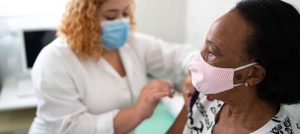CMS releases new oncology model that has payment incentives and downside risk
The Enhancing Oncology Model offers additional payment for enhanced services to patients who are dually eligible for Medicare and Medicaid.

Photo: The Good Brigade/Getty Images
The Center for Medicare and Medicaid Innovation has released a new, voluntary Enhancing Oncology Model intended to reduce spending and improve quality of care for cancer patients.
The EOM is a five-year voluntary model beginning on July 1 that has payment incentives and requires participant-redesign activities. The model will end in June 2028.
Under EOM, participating Physician Group Practices take on accountability for their patients' healthcare quality and for total spending during six-month episodes of care for Medicare patients with certain cancers.
EOM participants have the opportunity to earn a retrospective performance-based payment (PBP) based on quality and savings. Participants are required to take on downside risk from the start of the model (with the potential to owe CMS a performance-based recoupment).
EOM participants are required to implement participant-redesign activities, including 24/7 access to care, patient navigation, care planning, use of evidence-based guidelines, use of electronic Patient Reported Outcomes (ePROs), screening for health-related social needs, use of data for quality improvement and use of certified electronic health record technology.
EOM focuses on beneficiaries receiving systemic chemotherapy (that is, not beneficiaries receiving hormonal therapy only) for seven cancer types: breast cancer, chronic leukemia, small intestine/colorectal cancer, lung cancer, lymphoma, multiple myeloma and prostate cancer.
The model is national in scope. As of June 27, EOM participants consist of 67 oncology physician group practices. Across these participants there are over 600 sites of care, representing approximately 37 states nationally and over 3,000 unique practitioners, CMS said.
Approximately 15% of EOM participants' sites of care are located in a rural, small town or micropolitan area, with a little over half of EOM participants having previously participated in the Oncology Care Model (OCM).
EOM includes two risk arrangements with differing levels of downside risk. Both EOM risk arrangements qualify as a Merit-based Incentive Payment System (MIPS) Alternative Payment Model (APM) under the Quality Payment Program.
WHY THIS MATTERS
Under traditional Medicare fee-for-service, oncology providers and suppliers generally receive separate payments for each item or service furnished to a beneficiary during the course of their cancer treatment. This creates a financial incentive for some providers and suppliers to increase the volume of items and services or prescribe drugs that are high-cost but not necessarily higher value, CMS said. These actions may adversely affect the beneficiary with cancer, and the Medicare program.
In addition, traditionally, cancer care has focused on treating the disease, and not the person, which results in fragmented care. The oncologist's focus on the patient is typically limited to the time when they are in an exam room, with limited coordination with other providers involved in the patient's care, CMS said.
Additionally, Medicare beneficiaries may receive enhanced, patient-focused services, such as 24/7 access to an appropriate clinician with real-time access to patient medical records; patient navigation services (e.g., facilitating linkages to follow-up and/or support services, providing access to clinical trials as medically appropriate, etc.); and detailed care plans involving discussions with patients about prognosis, treatment options, symptom management, quality of life and psychosocial health needs, among other topics.
Medicare beneficiaries are not responsible for cost-sharing for any portion of the new EOM payment. They retain their freedom to choose any provider or supplier, and may also choose that their data not be shared with EOM participants.
Medicare beneficiaries under the model may provide feedback about their overall cancer care experience and health outcomes, such as those related to their symptoms, physical functioning, and behavioral health, through electronic devices. EOM participants also screen patients for health-related social needs (HRSNs), such as the lack of proper nutrition during chemotherapy or limited access to transportation to infusion appointments, that can contribute to and/or exacerbate cancer health disparities.
EOM is designed to test how best to place cancer patients at the center of the care team that provides high-value, equitable, evidence-based care. The model aims to improve care coordination, quality and health outcomes for patients, while also holding oncology practices accountable for the total cost of care.
EOM also includes a focus on improving health equity, another top priority for the Innovation Center. The health equity strategy for EOM:
- requires participating oncology practices to screen for health-related social needs.
- introduces data reports on expenditure and utilization patterns of each participant's patient population to help participating professionals identify and address health disparities.
- offers an additional payment for the provision of Enhanced Services to patients who are dually eligible for Medicare and Medicaid.
CMS provides participants the option to bill for a Monthly Enhanced Oncology Services (MEOS) payment for Enhanced Services provided to eligible beneficiaries. The MEOS payment is higher for beneficiaries dually eligible for Medicare and Medicaid.
These additional payments for dually eligible patients are not included in the practices' total cost of care responsibility. EOM participants will ask patients to routinely report their symptoms to encourage better communication and a more proactive care response. EOM participants are also required to submit plans to CMS outlining how they will promote health equity.
The model's design incorporates many of the lessons that CMS learned from the Oncology Care Model (OCM) that was tested from July 1, 2016 to June 30, 2022 and also feedback from the oncology community, including OCM participants, patient advocacy groups, oncology professional associations and others. Like OCM before it, EOM is a multi-payer model that aims to promote a consistent approach across payers and EOM participants' patient populations.
Similar to OCM, EOM focuses on value-based, patient-centered care for cancer patients with Medicare undergoing systemic chemotherapy over time in six-month episodes of care. Under EOM, participants are incentivized to consider the whole patient and engage with them proactively during and between appointments.
EOM aligns payment incentives with care quality, encouraging EOM participants to improve quality by implementing participant redesign activities. This includes some activities that were successfully implemented in OCM, such as patient navigation and care planning, and some that are new to EOM, including the gradual implementation of electronic Patient-Reported Outcomes (ePROs) and activities that promote health equity.
THE LARGER TREND
CMMI tests innovative payment and service delivery models that have the potential to reduce Medicare, Medicaid, and Children's Health Insurance Program (CHIP) expenditures while preserving or enhancing the quality of beneficiaries' care.
On February 2, 2022, the Biden-Harris Administration reignited the Cancer Moonshot to end cancer as we know it.
The ultimate goal of the model is to make cancer care more affordable and accessible for beneficiaries and Medicare, a key priority described in the Innovation Center's strategy refresh.
EOM aligns with President Biden's goals for his Cancer Moonshot, to decrease the cancer death rate by at least 50% over 25 years – saving and extending four million Americans lives – and to transform the experience of people who are touched by cancer, their families and their caregivers.
Twitter: @SusanJMorse
Email the writer: SMorse@himss.org












































